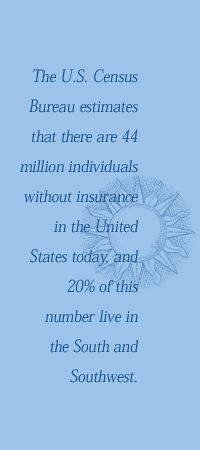

VI. Barriers to early detection and treatment of skin cancer in Texas
The Texas Community Futures Forum, a survey project of the Texas Agricultural Extension Service at Texas A&M University, found that 48 of 254 counties in Texas reported health care availability as a problem. (Appendix v) This included availability of prevention and wellness programs, and programs for both the very young and the very old. Of the 48 counties several were in close proximity to major metropolitan areas. [ 20 ]
The Federal Government's definition of medically underserved areas, even metropolitan areas, includes "percentage of population 65 and over, the poverty rate, the infant mortality rate, and the ratio of number of primary care physicians to the area's population." Only 29 counties in all of Texas are not designated by the Federal Government to be medically underserved. (Appendix vi) [ 24 ]
B . Fiscal barriers
The U.S. Census Bureau estimates that there are 44 million individuals without insurance in the United States today, and 20% of this number live in the South and Southwest. [ 25 ] In Texas, 24.5% of the population is uninsured, compared to a national average of 16.1%. Demographically, they are "young adults in the 18-24 yrs. age group, people with lower levels of education, people of Hispanic origin, those who work part time, and people born in another country." [ 27 ]
The cost of MM care, has been found to be higher in community settings than in metropolitan centers, due to the increased costs involved in the traditional referral pattern in community settings, versus the "coordinated multidisciplinary" approach found in medical centers. [ 28 ] These factors compound the already serious problem of a lack of insurance. Prevention and detection are less likely to be a priority for a population that seeks medical care only for emergency situations.
